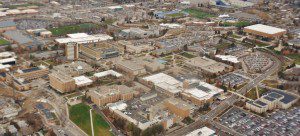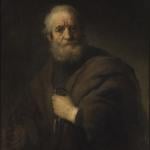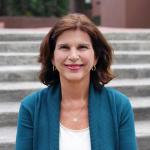
The Tanner Building is center, top.
“Exploring the Complexities in the English Language of the Book of Mormon”
A conference on the original English-language text of the Book of Mormon,
its language, concepts, and teachings
Saturday, 14 March 2015
9 a.m. – 1 p.m.
251 Tanner Building, BYU campus
jointly sponsored by BYU Studies and the Interpreter Foundation
participants:
John W. Welch, editor in chief, BYU Studies, final remarks
Daniel C. Peterson, professor of Islamic Studies and Arabic, BYU, and president of the Interpreter Foundation, conducting and providing remarks after presentations
Royal Skousen, professor of Linguistics and English Language, BYU; editor of the Book of Mormon Critical Text Project (1988-present); editor of The Book of Mormon: The Earliest Text (Yale University Press, 2009):
The process of translating the Book of Mormon, plus an examination of the Early Modern English vocabulary in the Book of Mormon, and the cultural and doctrinal history of the Post-Reformation in England and its role in the Book of Mormon narrative.
Stanford Carmack, independent linguistics scholar, JD from Stanford University, PhD in Spanish linguistics from University of California at Santa Barbara and BA in linguistics from Stanford:
The nonstandard grammar of the original Book of Mormon and its occurrence in Early Modern English, as well as evidence that some Book of Mormon usage cannot date from the English language of the early 1800s or from the King James Bible.
Jan Martin, assistant visiting professor of Ancient Scriptures, BYU; wrote PhD at the University of York in England, 2011, “Establishing an English Bible in Henry VIII’s England: Translation, Vernacular Theology, and William Tyndale”:
The translation vocabulary introduced by Tyndale in his 1526 translation of the New Testament from the Greek and the strong Catholic reaction from Sir Thomas More, based on his reading of the Latin Vulgate, plus evidence that Tyndale’s usage was common for his time.
Nick Frederick, assistant professor of Ancient Scriptures, BYU; PhD on the New Testament in the Book of Mormon at Claremont
The use of biblical phraseology, especially the King James New Testament phraseology, throughout the Book of Mormon text, not just in biblical paraphrases but specifically interwoven throughout the text as the familiar biblical style of religious language.
Overview
There is considerable evidence that the Book of Mormon is a religious text culturally translated into the English language of the 1500s and 1600s, and that it assumes familiarity with many of the issues of the Protestant Reformation and the Catholic Counter-Reformation, especially as they were being resolved in England and on the European Continent during that time period.
The first recognition of this dating of the text’s language occurred with the discovery (first published in 2005) that the vocabulary of the original English text of the Book of Mormon – that is, the lexical use of words and phrases – does not date from the early 1800s, but rather from Early Modern English, with numerous word uses specifically identified as having existed in England from the 1540s through the 1730s.
And within the last couple years (2013-15), it has been discovered that the so-called bad grammar of the original text can also be dated from Early Modern English, that nearly all the expressions that the Book of Mormon has been ridiculed for over the years can actually be found in standard printed texts from the late 1400s up into the early 1700s, long before prescriptive notions of the English language had arisen to mislead early readers of the Book of Mormon into interpreting the English of the Book of Mormon as nonstandard American dialect.
Other research has identified the use of the language of the 1611 King James Bible as playing a more central role in the text of the Book of Mormon. To be sure, there are the large portions of the King James versions of Isaiah and Matthew quoted in the Book of Mormon, with some significant differences, but more importantly it has now been discovered how the phraseology of the King James Bible, especially its New Testament passages, is used by Book of Mormon writers, not just in paraphrases of biblical passages, but in expressing ideas that are at best indirectly related to their New Testament sources.
And finally, there is the subject matter of the Book of Mormon text itself. Alexander Campbell claimed in his 1831 review of the Book of Mormon that Joseph Smith’s golden bible was simply commenting on the religious and political issues of the early 1800s in America. Unfortunately, Campbell’s list of subject matter seems to derive from only a cursory examination of the book and in some places it just seems to be made up (items identified by an exclamation mark):
This prophet Smith, through his stone spectacles, wrote on the plates of Nephi, in his book of Mormon, every error and almost every truth discussed in New York for the last ten years. He decides all the great controversies – infant baptism, ordination, the trinity, regeneration, repentance, justification, the fall of man, the atonement, transubstantiation (!), fasting, penance (!), church government, religious experience, the call to the ministry, the general resurrection, eternal punishment, who may baptize, and even the question of freemasonry (!), republican government, and the rights of man. All these topics are repeatedly alluded to.
There is no discussion or arguments in the Book of Mormon over the trinity per se (it is simply assumed); there is no reference to regeneration except as the process of repenting and being born again; there is definitely no discussion of transubstantiation versus its alternatives; and since the word repentance is already in Campbell’s list, the word penance must be something else (yet there is definitely no mention of the Catholic notion of “doing penance” in the Book of Mormon). Campbell produced a dubious list that needs to be carefully scrutinized.
More precisely, there is considerable evidence that the issues and the cultural milieu of the Book of Mormon resonate more with the 1500s and 1600s in England than to the early 1800s in American, to a time when the conflicts between the low-church Protestants, high-church Anglicans, and Catholics were being resolved in England (or at least reaching a kind of peaceful truce in the late 1600s). References to “secret combinations”, “burning at the stake”, and “standing at the bar of God to be judged” can be more reasonably traced to this earlier period, not to the 1800s. Similarly, numerous issues brought up by Reformed Protestants on the European Continent, issues involving infant baptism, baptism by immersion, simplicity in dress, and avoidance of high church ritual, can also be found throughout the Book of Mormon.
In addition, the translation issues that Thomas More viciously attacked William Tyndale over (in the late 1520s and early 1530s) were, more or less, settled on in the King James Bible (1611), yet the Book of Mormon takes those translation issues to their final conclusion by explicitly resolving the linguistic conflicts by (1) declaring charity to be the “pure love of Christ”, (2) allowing for both elders and priests as officers in the church, and (3) explicitly stating that the word church refers to both congregations and God’s organization. And More’s preference for “doing penance” rather than Tyndale’s “repenting” is simply ignored, as it is in the King James Bible. Moreover, Tyndale’s translation choices can be supported from actual language usage in the early 1500s in England, contrary to More’s adamant claims to the contrary.










